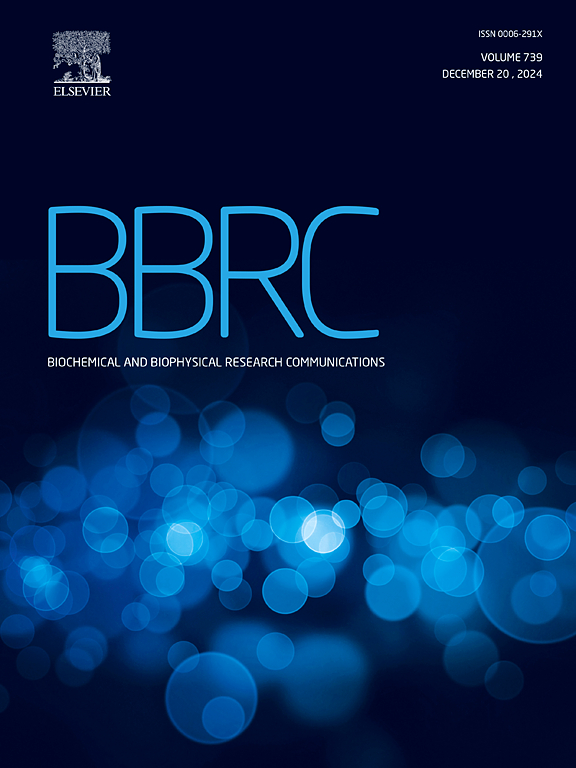5-氟尿嘧啶通过靶向SLC7A11诱导乳腺癌细胞铁下垂
IF 2.5
3区 生物学
Q3 BIOCHEMISTRY & MOLECULAR BIOLOGY
Biochemical and biophysical research communications
Pub Date : 2025-05-09
DOI:10.1016/j.bbrc.2025.151972
引用次数: 0
摘要
乳腺癌(BC)是全世界妇女癌症死亡的主要原因之一。5-氟尿嘧啶(5-FU)是目前广泛应用于乳腺癌的化疗药物,其抑制BC的机制尚不清楚。铁下垂是一种程序性细胞死亡模式,由铁依赖性脂质过氧化作用决定。本研究的目的是探讨铁下垂是否与5- fu诱导的BC细胞损伤有关。在本研究中,我们发现铁代谢和SLC7A11/GPX4信号可能在体外5-FU诱导BC细胞死亡中起关键作用。在体外实验中,我们发现5-FU暴露显著增加MCF-7和MDA-MB-231细胞中的铁和活性氧(ROS)水平。此外,铁下垂抑制剂铁抑素-1可抑制5-FU诱导的细胞死亡。随后的western blotting、qRT-PCR、各种试剂盒的测定、荧光染色和细胞热移实验证实了5-FU通过靶向BC细胞SLC7A11诱导铁下垂的结果。综上所述,我们的研究结果揭示了5-FU暴露通过靶向抑制SLC7A11/GPX4信号通路导致BC细胞铁凋亡,这为5-FU在BC治疗途径中的药理学作用和机制提供了新的见解。本文章由计算机程序翻译,如有差异,请以英文原文为准。
5-Fluorouracil induces ferroptosis in breast cancer cells via targeting SLC7A11
Breast cancer (BC) is one of the major causes of cancer mortality worldwide among women. 5-Fluorouracil (5-FU) is a widely used chemotherapy drug to treat breast cancer, which is unclear that the mechanism of inhibiting BC. Ferroptosis is a mode of programmed cell death determined by iron-dependent lipid peroxidation. The aim of the study was to investigate whether ferroptosis is involved in 5-FU-induced BC cell injury. In the current study, we found that iron metabolism and SLC7A11/GPX4 signaling may play a key role in cell death of BC induced by 5-FU in vitro. In vitro experiments, we found that 5-FU exposure significantly increased the levels of iron and reactive oxygen species (ROS) in MCF-7 and MDA-MB-231 cells. Furthermore, ferrostatin-1, the ferroptosis inhibitor, inhibited cell death induced by 5-FU. Subsequent western blotting, qRT-PCR, and measurement of various kits, fluorescence staining as well as cellular thermal shift assay, confirmed the results that 5-FU induces ferroptosis by targeting SLC7A11 in BC cells. In conclusion, the results in our study reveals that 5-FU exposure leads to ferroptosis in BC cells via targeting inhibition of SLC7A11/GPX4 signaling pathway, which offers novel insight in pharmacodynamic effect and mechanism of 5-FU in therapeutic avenues of BC.
求助全文
通过发布文献求助,成功后即可免费获取论文全文。
去求助
来源期刊
CiteScore
6.10
自引率
0.00%
发文量
1400
审稿时长
14 days
期刊介绍:
Biochemical and Biophysical Research Communications is the premier international journal devoted to the very rapid dissemination of timely and significant experimental results in diverse fields of biological research. The development of the "Breakthroughs and Views" section brings the minireview format to the journal, and issues often contain collections of special interest manuscripts. BBRC is published weekly (52 issues/year).Research Areas now include: Biochemistry; biophysics; cell biology; developmental biology; immunology
; molecular biology; neurobiology; plant biology and proteomics

 求助内容:
求助内容: 应助结果提醒方式:
应助结果提醒方式:


